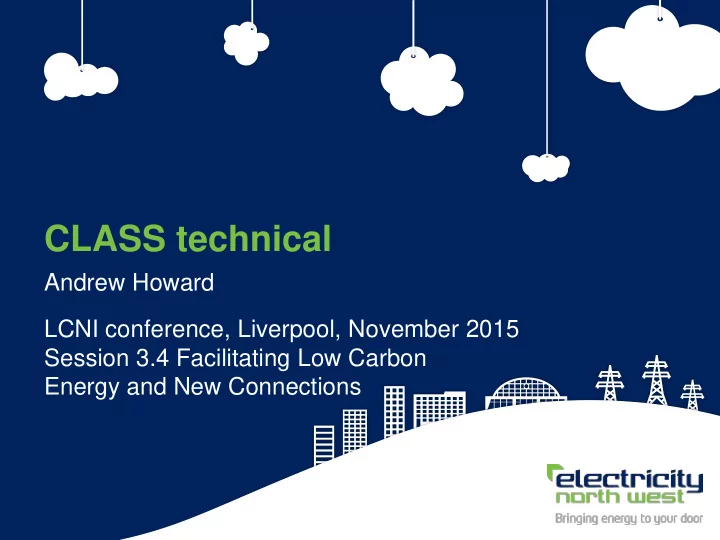

CLASS technical Andrew Howard LCNI conference, Liverpool, November 2015 Session 3.4 Facilitating Low Carbon Energy and New Connections 1
Back to school for a moment… This fundamental relationship is at the heart of CLASS But how will it change over time as customers adopt new devices? How could we use this relationship in a smart way to benefit customers? 2
How does it work? 00:03:00 00:00:08 00:00:08 2% 2% The cost £ to make your cup of tea is always the same! 20,000 homes in a town “ A problem shared is a problem 200,000 homes in a city halved ... ” 26 million across the GB What problems could we solve ? 3
CLASS aims to harness thousands of tiny changes at just the right time Today Tomorrow Future High peak demand Respond and reserve Wind following Primary and secondary frequency response Facilitates demand boost Reduces peak demand Allows more renewable Lower energy costs Faster LCT connections generation Mitigates inertia issues Lower network cost Flexible reactive power absorption 4
The CLASS functions Objective Technique Automatic Reduce demand to within peak Lower tap position substation capacity reduction Demand boost / Boost or reduce demand Lower / higher tap position reduction Primary response to reduce demand when frequency falls Switch out transformer on the network Frequency response Secondary response to reduce demand when frequency fails Lower tap position on the network Absorb high voltages that Reactive Stagger tap position occur on the transmission power network 5
Typical substation overview AVC AVC AVC AVC RTU X X X 6
Typical primary arrangement - Golborne 33kV 11kV TAP 6 X X TAP 6 7
Golborne area 8
Typical primary arrangement - Golborne 33kV 11kV TAP 6 X X TAP 6 9
Primary transformer 10
Typical operation - Golborne Voltage 33kV 6 7 TAP Time X X TAP 6 7 11
Complete CLASS system Control room Substation Algorithm T11/T12 TX Soap Circuit ASC AVC (Transformers) Breaker Dashboard PoF NMS ICCP Link Primary CRMS Dashboard NG NMS RTU Monitors NMS HV & LV iHost Envoy monitors 12
What is an ICCP link? Firewall Firewall ICCP link 2 circuits Secure inter control centre protocol is the industry standard Direct fibre optic connection Enables data exchange between energy management systems 13
Monitoring 14
Daily demand curve 12 12 Substation capacity 10 10 Demand 8 8 Demand (MVA) Demand (MVA) 6 6 4 4 2 2 0 0 00:30 00:30 03:30 03:30 06:30 06:30 09:30 09:30 12:30 12:30 15:30 15:30 18:30 18:30 21:30 21:30 Time Time 15
Peak reduction - Golborne 12 33kV Demand (MVA) 10 8 6 6 4 TAP 4 2 0 Time X X TAP 6 4 16
Peak reduction - Golborne 12 33kV Demand (MVA) 10 8 6 4 6 TAP 4 2 0 Time X X TAP 6 4 17
Primary frequency response - Golborne Voltage 33kV 6 TAP Time X X TAP 6 18
Secondary frequency response - Golborne Voltage 33kV 6 4 TAP Time X X TAP 6 4 19
Reactive power response - Golborne Voltage 33kV 4 7 TAP Time X X TAP 4 1 20
Demand reduction / boost - Golborne Voltage 33kV 6 4 TAP Time X X TAP 6 4 21
Academic research Demand profiles through modelling and Demand response quantification validation using trial data methodology and results Q absorption capability and availability study Asset health Carbon impact based on EHV network 22
Trial 1 voltage/demand relationship Mixed Mainly Mainly domestic industrial/ commercial 1% change 1% change in voltage ~ in voltage ~ 1% change 1.3% 1.22% in voltage ~ change in change in 1.48% real power real power change in real power 23
Demand response (DR) Great Britain Great Britain 5% VR = 6%DR 6% VR =7.2%DR Summer Winter Summer Winter Minimum maximum Minimum maximum demand demand demand demand response = response = response = response = 1120MW 3150MW 1340MW 3780MW 24
Reactive power absorption Great Britain Spring Summer Autumn Winter 1419MVAr to 1474MVAr to 1452MVAr 1441MVAr 1716MVAr 1672MVAr to1749MVAr to1837MVAr 25
Did customers notice CLASS? No differences by customer type, trial type, region, vulnerable customers, survey season 485,000 customers No complaints from customers about power quality that could be attributed to CLASS Customers did not notice the CLASS tests 26
Summary Statistical findings Lessons have been CLASS has CLASS has shown are that domestic an approximately learned during the provided National customers did not linear relationship installation phase, Grid with the ability notice the CLASS between voltage that can be to use an ICCP link functions and demand integrated into any which provides future ‘rollout’ them with a demand response during a system frequency event 27
High level benefits Low cost high speed frequency support 3GW demand reduction or boost 2GVAr National Grid voltage control Reinforcement deferral 24/7 voltage/demand relationship matrix 28
Recommend
More recommend